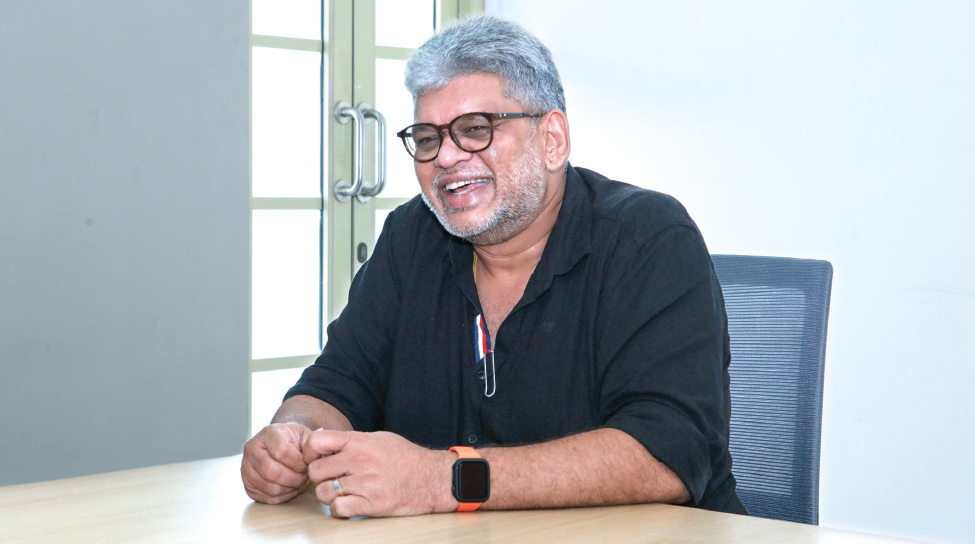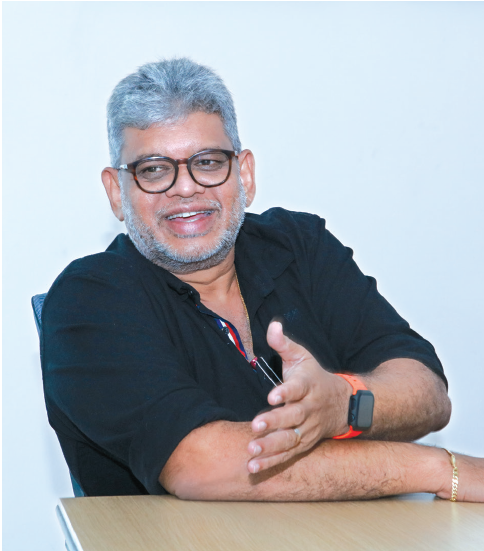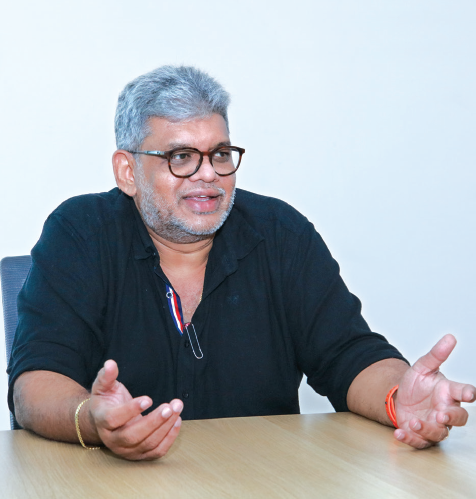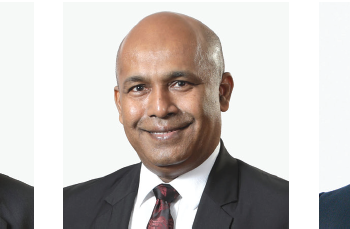Chartered architect Rajiv Senanayake co-founded Design Forum with architect Lilantha Wijayapala in 2000, a company of chartered architects, consultants and designers. In his long career, first working under senior architects and then launching on his own, Rajiv has undertaken many projects in Sri Lanka and abroad, from residences to designing, renovating and restoring interiors for corporate, hospitality, institutional and retail spaces. He is progressive in his sentiments about what he wants for his country to create an enabling environment for all sectors and professions to flourish. A great proponent of change and a country loyalist, Rajiv, speaking to Business Today, still has hope for a new Sri Lanka. He is holding out for a change that will positively impact the profession that he serves with immense passion. He is confident that Sri Lanka’s immensely talented architects can navigate the next phase of development with some push from those in authority and a commitment to allow them to define Sri Lanka’s landscape within its strengths and perch it among the best-planned countries in the world.
Words: Jennifer Paldano Goonewardane.
Photography: Sujith Heenatigala and Dinesh Fernando.

What do you like most about working as an architect in Sri Lanka?
I enjoy my profession’s opportunity to interact with people, listen to their desires and guide them towards their dream projects. Because passion for my work drives me, I feel the rush of creative adrenaline whenever I sit to design. It’s like a vast playground I can dip into to transfer my skills. And I am glad I still retain the spark for my chosen profession, with a keen eye for new ideas that I don’t hesitate to incorporate into my work. Design Forum has completed 24 years because I still feel excited about every new project and the opportunity to create while combining our core function with business acumen. Design forte and business sense amalgamate to sustain the practice and the people working there. With that focus, our projects are a mix of those that fuel our creative fiber and fire to harness our passion to the hilt, while others are projects that provide stability and sustenance as a business. And it is this combination that pushes me to keep going.
At my first company as a young architect, I envisioned myself at 50 to be relaxed while others operated the office. However, when I launched Design Forum with my partner, I realized architecture is more than running a practice. I have four architects working with me. While giving them design freedom, I am involved in every project, visiting the sites and looking at how the design takes shape. I have a hands-on approach to my work.
What is your design philosophy?
An architect’s job varies according to the client. The residential projects are smaller than the corporate, hospitality, retail, and institutional projects. We interact and collaborate in both instances. Unlike residential spaces, business space designing involves interacting with a range of people whose requirements we must meet through our design. An office is where people spend nearly nine hours of their day; hence, it should differ from a government office where hierarchies divide people. We break that archaic mold, and any form of separation is subtle and aesthetically introduced.
We have broken hierarchy-induced boundaries in our office design. We sit as equals at meetings with no chair at the head of the table. It’s a practice that we, through design, are trying to change to make workspaces more cordial and refined. These are lessons that I’ve learnt over the years from overseas exposure, and I encourage my staff to adopt these changes in their output.
Since you spoke of fusing passion with business and your commitment to bringing a project to fruition, do you face any design constraints?
Material shortage poses a significant constraint in realizing our design ideas fully. The enormity of material used in design elsewhere is impressive. More investment in technology to manufacture contemporary products will augment our work. But we do have the strength of a skilled workforce. We have some of the best carpenters who can still use their bare hands to carve or the training to use a laser cutter to do the same with precision. Again, we may lose that skill to a reluctant next generation of sons. The sons are equally capable, as some have been through technical colleges, but they need on-the-job training, patience and passion.
In addition, we need more creative engineers. An engineer’s creative flair helps an architect to implement the designs practically. Because there has been a pushback to implementing new design features, Sri Lanka needs to be faster to adopt them.
Lack of learning opportunities and exposure to new global design trends is also a drawback. No longer can we confine ourselves to the design ideas of Sri Lanka’s veteran architects. We can combine the old with the modern to make it appealing and practical. Our clients come with a picture album of different architectural styles, expecting our guidance to incorporate their many expectations into a single project. We succeed in our role if we achieve congruence from the diverse ideas that a client presents. We can do that well with augmented knowledge acquired from exposure to new design trends and drifts worldwide.
Do you face technology constraints?
The cost of design software is a considerable constraint in our practice. We can’t sustain buying design software licenses for three thousand dollars per machine annually, which would be ten times more if we worked with ten devices. Spending thirty thousand dollars is a lot for a single entity. There should be a global collective to distinguish this standard for countries like Sri Lanka. Their unaffordability has led individuals with no choice but to seek recourse in pirated design software. Ideally, every practitioner should be working with original software to maintain standards. Licensed design software is a must for anyone working with foreign clients.
To our benefit and reputation, we should use original software for presentations at international forums attended by a global audience of professionals. We must speak of these constraints to create a better enabling environment for future architects as we witness software companies tightening the noose on pirated design software.
As the influence of artificial intelligence intensifies, even in architectural design, we must be ready for the changes, lest we lose out on the momentum. As we look to broaden our horizons, work with foreigners and work on potential projects in places like Port City, we must possess the means to compete in that evolving and promising environment.
How do institutional rules and regulations, like inconsistency, bribery, corruption, and favoritism, impact the industry?
The enormous regulations that stymie progress can only turn some government office counter into a toll gate that we navigate by paying off someone to move to the next phase. There are several ways to stop the corruption.
One, the government could increase the fee for approvals. That benefit, in turn, should be transferred to the officers in charge. It’s serious when owners quickly pay less illegally to expedite the approvals. The result is less stringent and haphazard approvals.
I support employing architects in government offices to manage these processes because they know the subject. We must have the right person in the right place. But they should be compensated adequately for their years of education. Archaic practices, lengthy procedures, and delays keep investors from Sri Lanka. We cannot justify how we work as a South Asian phenomenon. Even if we make more port cities in the future, the expected benefits will not accrue if we fail to change the system and are ready to work on a new one.
Do the loopholes and the delays impact the outcome?
Compare the wishy-washy facades dotting our streets with foreign cities. We need more planning and design guidelines, evident in our facades that lack aesthetics and congruity. The problem lies partially with those granting approvals. That includes inexperienced technical staff who barely know the subject and those who want to put a spoke in the wheel through delays and arguments, and the result is what we see in the disorganized facades and unsafe buildings as people opt to take the shorter of the routes.
Our buildings end up badly designed because architects are not taken seriously, not even by our governments. For these reasons, I am pushing architects to join the government sector to facilitate the processes rightfully. Architects working in local councils are standard in other countries. Two of my architects have joined local government offices. That could be the start of the envisaged change. The right people in the right places with adequate wages and fee revisions will set the wheel of change in motion.
The involvement of foreign architects in local projects is another new trend, which is good after thirty years of the war, which had limited our scope and slowed the expansion of our design potential. But we must enforce regulations that foreign architects must work with local architects. That is the practice elsewhere. I operate in Africa, Bangladesh and the Maldives, where I provide the design while their local architects draw the plan as per the code and approve it. Sri Lanka lacks regulations that compel foreign architects working on massive projects to collaborate with a Sri Lankan counterpart, limiting our role to signing off on their drawings. That needs to change as well.
Condominium projects have propped everywhere, especially in Colombo, some despite not being suitable for large-scale constructions, and we see them being sold and occupied as residences. What are the dangers of such a trend continuing?
Wellawatte is the best testament to the uncontrolled construction of apartment complexes. They are a staple in that locality, adjacent to each other, constructed in violation of accepted standards and regulations. Authorities must determine whether they leave the stipulated room for a fire truck to enter. Disasters are waiting to happen in some of these places. But I wonder whether local authorities ignore apartment safety and don’t push administrators to conduct safety audits regularly. It boils down to people understanding the importance of ensuring the safety of buildings and their residents on an ongoing basis and their willingness to spend on the process.
The danger is that no one seems responsible for maintaining the rules and safety protocols. The biggest problem lies in the failure to update systems. Too many loopholes allow individuals to manipulate the system to have their way, setting a wrong precedent that continues to endanger people’s lives, undermining the quality of the product and lowering industry standards.
Sustainable architecture is gaining momentum everywhere. But how practical is it amid budget constraints? Is it something that only a few can afford?
Many architects want to reduce their carbon footprint, but green building rating and certification processes are costly, which only a few can afford. The more money one spends, the higher the certification. For instance, when we designed a warehouse on green principles, the emphasis was on natural light absorption and natural extraction of heat with brick and clay facades. However, the certifying authority demanded air-conditioning instead, and installing the specific air-conditioning system they promoted earned the building more points. The air conditioning cost was huge, but the company got platinum certification for the warehouse. It is an unfortunate trend where more money on the table means a higher certificate, but it benefits the implementer and shows the entity in a positive light. It all makes sense when businesses operate in a buyer-driven market where owners have to address the concerns of their clients. It is the same with hotels, as they cater to the desires of their clients. Sometimes buyers demand that transition, like in Bangladesh, where their factories have become more eco and worker-friendly.
Sri Lanka has many impressive old buildings. Is it viable to restore them?
As a company, we focus on reusing, reprocessing and renovating in keeping with the design ethos of sustainability. Sri Lanka has a lot of colonial buildings. Some have been beautifully renovated and restored.
But restoring old buildings is an expert-driven process because we must maintain their original design. Restoration projects happen worldwide, guided by specialists trained in such. Singapore’s CHIJMES is a vibrant cityscape set on an old monastery and church site. From the outside and inside, the edifice retains its old architectural beauty. A basement surrounding the old monastery throbs with energy as a dining and entertainment haven with clubs, cafes and eateries. We can follow the same method to restore and reuse our old buildings. The Maradana Trace City is one such project, beautifully converted from its former identity as a market square into a series of office spaces and other conveniences. Assisting in restoration projects through the Institute of Architects will be a privilege for us, which I hope those in decision-making will consider.
You have spoken of the constraints and potential in your profession. In that light, how do you see the opportunities for local architects in a burgeoning project like the Port City, which is an enormous project that is unfolding in the coming years?
There is much potential for businesses and professionals in the Port City. A mega project like the Port City is vital for Sri Lanka to move from its conventional development and investment agenda to offer something innovative and relevant. Individuals had expressed their concerns regarding the environmental impact of the project. However, the Maldives, threatened by rising sea levels, have successfully reclaimed land to expand their islands since the 1990s. It has completed phase two of the Hulhumale project while expanding into the next phase of extensions. Although Port City’s development is growing slower than envisaged, it offers many opportunities for our involvement. The project’s magnitude as an extension of Sri Lanka’s commercial capital may require foreign expertise. Not all local architects can service the enormity of the new multifaceted Port City and its infrastructure. However, local architects must be part of the process, a collaborative exercise between foreign and local experts like in other countries. The State must impose that rule on the developers. The Port City will have a colossal trickling effect once construction and investments get going, helping architects, engineers, masons, and other subsidiary service providers get more work.
With enormous amounts of unused land, many areas in Sri Lanka have the potential for mega projects, such as satellite cities. They could be the answer to narrowing the disparity between Colombo and the provinces and help retain professionals in those areas. They are an enormous opportunity for us as well.
Many architects want to reduce their carbon footprint, but green building rating and certification processes are costly, which only a few can afford.

Sri Lanka is experiencing a skills drain under the current economic stress. What can you tell us about your field?
I’ve lost three architects from my company. When they decided to leave, things didn’t look good for them or the country. But leaving the country will not solve our problems. The problem lies in the system’s failures, the constraints, and the need for an enabling environment.
The way forward for Sri Lanka lies in resetting our attitudes and correcting many mistakes, which we have discussed for a long time but have done nothing. From changing the education system to the electoral process to breaking hierarchies are long overdue undertakings. People leaving for better pay outside is not unreasonable in certain situations. Sometimes, appalling working conditions don’t help people earning low wages who feel deprived of dignity. Construction industry workers in Sri Lanka live in inadequate conditions at their work sites.
Poor working environments produce demotivated employees, and low pay adds to it, forcing most to seek employment outside, where they willingly forgo the discomforts of living for higher wages. Under such circumstances, would parents want their children to follow the family profession? That robs the country of skilled workers. So, we know there is a problem, but no one’s willing to stay back to fix the problem. The very people with the skill and the power to change the landscape are leaving the country. But change doesn’t happen in a vacuum. For instance, change will become a natural progression for employees when they receive training and education opportunities to learn new trends and skill sets related to their field. When we speak of change in Sri Lanka, it’s for the better, and for that, all those with the power to do that must begin with their professions, like the architects and the various service providers connected to the industry changing themselves and the way they work to ensure better outcomes. All this will have a trickle-down effect.
I belong to a generation of Sri Lankans who have been through the vicissitudes of political decision-making, food queues, wars and insurgencies. Despite those challenges, we remained in this country to grow in our chosen fields, which shows hope in overcoming any problematic situation. The positivity that everyone expounds these days should extend beyond words to embody it as professionals in our work and its delivery. The way forward is through change, doing away with unnecessary hierarchies, learning to respect each other and replacing archaic and constraining rules with progressive ones to create new mindsets and working methods.
The way forward for Sri Lanka lies in resetting our attitudes and correcting many mistakes, which we have discussed for a long time but have done nothing. From changing the education system to the electoral process to breaking hierarchies are long overdue undertakings.






